Deformation Characteristics and Stability Prediction of Mala Landslide at Miaowei Hydropower Station under Hydrodynamic Action
Abstract
:1. Introduction
2. Engineering Geological Conditions of Landslides
3. Deformation Characteristics and Mechanism Analysis of Landslide
3.1. Development Characteristics of Landslide
3.1.1. Geometric Characteristics of the Slope
3.1.2. Characteristics of Sliding Body
3.1.3. Characteristics of Slip Zone
3.1.4. Sliding Bed Characteristics
3.2. Deformation and Failure Characteristics of Landslide
3.2.1. Distribution Characteristics of Cracks in Landslide
3.2.2. Deformation Monitoring of Landslide
- (1)
- Apparent displacement of Mala landslide
- (2)
- Deep displacement monitoring of landslides
3.3. Analysis of Factors Influencing Landslide Stability and Evolution Process
3.3.1. The Impact of Reservoir Storage on Landslides
3.3.2. The Impact of Concentrated Rainfall on Landslide
3.3.3. Analysis of Landslide Evolution Process
- (1)
- Small-scale bank collapse stage (13 June to 20 June 2017)
- (2)
- Creep deformation stage (21 June to 12 July 2017)
- (3)
- Accelerated sliding stage (13 July to 13 September 2017)
- (4)
- Uniform sliding stage (14 September to 13, June 2017)
4. Prediction Results of Landslide Deformation Trend Considering Hydrodynamic Effects
4.1. Calculation Parameters and Models
4.2. Deformation Simulation of 1401 m Water Storage Condition
4.3. Deformation Simulation of Rainstorm Conditions
4.4. Deformation Simulation under Earthquake Conditions
5. Conclusions
- (1)
- Based on the statistical analysis of the extension direction and width of cracks exposed within the landslide area, it is concluded that the overall sliding direction of the landslide is towards the downstream side of the Lancang River. The position of the center of gravity of the sliding mass is speculated to be located in the middle downstream part of the sliding mass, and there may be a protruding locking section on the right side of the landslide mass, which could block the sliding of the upstream rock and soil.
- (2)
- The monitoring data for the apparent displacement within the landslide area shows that as of 7 June 2018, the maximum displacement in the X direction of monitoring point TP-H6-2 is 107 mm. The maximum displacement in the Y direction of monitoring point TP-H6-8 is 480 mm, and the maximum displacement in the Z direction of monitoring point TP-H6-6 is 316 mm. In deep displacement monitoring, the position of the sliding surface can be roughly determined based on the cut position of the inclinometer tube.
- (3)
- Based on comprehensive analysis, the main factors affecting landslide stability include reservoir impoundment, bank collapse, concentrated rainfall, and additional loads. Based on the deformation monitoring data and theoretical analysis of the landslide mass, it is believed that the evolution process of the landslide mass from the beginning of water storage to now mainly includes four stages: small-scale bank collapse stage, creep deformation stage, accelerated sliding stage, and uniform sliding stage. The overall stage of the landslide manifestation is in the creep stage, and the front foot of the landslide is softened by immersion in water, resulting in significant deformation of the front of the slope and instability. It may lose stability during the process of reservoir water level rise, sudden drops, rainstorms, earthquakes, and other operating conditions.
- (4)
- The results of the 2D finite element numerical simulation of the landslide mass show that shear stress concentration occurs in the middle and lower parts of each sliding zone of the landslide, and there is a phenomenon of tensile stress concentration at the trailing edge of the sliding body. The sliding mass exhibits a trend towards leading edge traction and trailing edge rock and soil sliding.
Author Contributions
Funding
Data Availability Statement
Acknowledgments
Conflicts of Interest
References
- Fannin, J. Karl Terzaghi: From theory to practice in geotechnical filter design. J. Geotech. Geoenviron. Eng. 2008, 134, 267–276. [Google Scholar] [CrossRef]
- Imam, S.M.R.; Morgenstern, N.R.; Robertson, P.K.; Chan, D.H. Yielding and flow liquefaction of loose sand. Soils Found. 2002, 42, 19–31. [Google Scholar] [CrossRef]
- Lade, P.V.; Duncan, J.M. Elasto-plastic stress-strain theory for cohesionless soil. J. Geotech. Eng. Div. 1975, 101, 1037–1051. [Google Scholar] [CrossRef]
- Nuria, M.P.; Eduardo, E.A. [24 h] Criteria for rapid sliding, I.I. Thermo-hydro-mechanical and scale effects in Vaiont case. Eng. Geol. 2010, 114, 211–227. [Google Scholar] [CrossRef]
- Huang, R.; Qi, S. Engineering Geology: Review and Prospect of Past Ten Years in China. J. Eng. Geol. 2017, 25, 257–276. [Google Scholar] [CrossRef]
- Tan, L.; Huang, R.; Pei, X. Deformation characteristics and inducing mechanisms of a super-large bedding rock landslide triggered by reservoir water level decline in Three Gorges Reservoir area. Chin. J. Rock Mech. Eng. 2021, 40, 302–341. [Google Scholar]
- Cotecchia, F.; Vitone, C.; Santaloia, F.; Pedone, G.; Bottiglieri, O. Slope instability processes in intensely fissured clays: Case histories in the Southern Apennines. Landslides 2015, 12, 877–893. [Google Scholar] [CrossRef]
- Paronuzzi, P.; Bolla, A.; Rigo, E. Brittle and Ductile Behavior in Deep-Seated Landslides: Learning from the Vajont Experience. Rock Mech. Rock Eng. 2016, 49, 2389–2411. [Google Scholar] [CrossRef]
- Qin, R.; Hai, Z.; Ling, F. Considering the effect of reservoir water level lift in gone slope stability. Electron. J. Geotech. Eng. 2014, 19, 3191–3200. [Google Scholar]
- Wu, S.; Hu, X.; Zheng, W.; Zhang, G.; Liu, C.; Xu, C.; Zhang, H.; Liu, Z. Displacement behaviour and potential impulse waves of the Gapa landslide subjected to the Jinping Reservoir fluctuations in Southwest China. Geomorphology 2022, 397, 108013. [Google Scholar] [CrossRef]
- Li, D.; Nian, T.; Tiong, R.L.K.; Shen, Y.; Shao, Z. River blockage and impulse wave evolution of the Baige landslide in October 2018: Insights from coupled DEM-CFD analyses. Eng. Geol. 2023, 321, 107169. [Google Scholar] [CrossRef]
- Cao, Z.; Tang, J.; Zhao, X.; Zhang, Y.; Wang, B.; Li, L.; Guo, F. Failure Mechanism of Colluvial Landslide Influenced by the Water Level Change in the Three Gorges Reservoir Area. Geofluids 2021, 2021, 6865129. [Google Scholar] [CrossRef]
- Wang, R.; Zhang, K.; Qi, J.; Xu, W.; Wang, H.; Huang, H. Correlation Analysis of Influencing Factors and the Monthly Displacement Increment of a Hydrodynamic Landslide Using a Pseudo-Maximum-Likelihood-Estimation-Mixed-Copula Approach. Front. Earth Sci. 2021, 9, 637041. [Google Scholar] [CrossRef]
- Canoglu, M.C.; Aksoy, H.; Ercanoglu, M. Integrated approach for determining spatio-temporal variations in the hydrodynamic factors as a contributing parameter in landslide susceptibility assessments. Bull. Eng. Geol. Environ. 2019, 78, 3159–3174. [Google Scholar] [CrossRef]
- Wang, S.; Pan, Y.; Wang, L.; Guo, F.; Chen, Y.; Sun, W. Deformation characteristics, mechanisms, and influencing factors of hydrodynamic pressure landslides in the Three Gorges Reservoir: A case study and model test study. Bull. Eng. Geol. Environ. 2021, 80, 3513–3533. [Google Scholar] [CrossRef]
- Mishra, V.; Jain, K. Satellite based assessment of artificial reservoir induced landslides in data scarce environment: A case study of Baglihar reservoir in India. J. Appl. Geophys. 2022, 105, 104754. [Google Scholar] [CrossRef]
- Kohler, M.; Hodel, D.; Keller, L.; Molinari, A.; Puzrin, A.M. Case study of an active landslide at the flank of a water reservoir and its response during earthquakes. Eng. Geol. 2023, 232, 107243. [Google Scholar] [CrossRef]
- Kędra, M.; Wiejaczka, Ł.; Zydroń, T.; Kijowska-Strugała, M.; Cebulski, J. The influence of water level hydrodynamics on potential changes in the morphology of a mountain reservoir shore zone. Catena 2023, 231, 107363. [Google Scholar] [CrossRef]
- Ghiassian, H.; Ghareh, S. Stability of sandy slopes under seepage conditions. Landslides 2008, 5, 397–406. [Google Scholar] [CrossRef]
- Kalenchuk, K.S.; Hutchinson, D.J.; Diederichs, M.S. Downie Slide: Numerical simulation of groundwater fluctuations influencing the behaviour of a massive landslide. Bull. Eng. Geol. Environ. 2013, 72, 397–412. [Google Scholar] [CrossRef]
- Wang, F.W.; Okuno, T.; Matsumoto, T. Deformation characteristics and influential factors for the giant Jinnosuke-dani landslide in the Haku-san Mountain area, Japan. Landslides 2007, 4, 19–31. [Google Scholar] [CrossRef]
- Castelli, M.; Scavia, C.; Bonnard, C.; Laloui, L. Mechanics and velocity of large landslides. Eng. Geol. 2009, 109, 1–4. [Google Scholar] [CrossRef]
- Quinn, P.; Hutchinson, D.; Diederichs, M.; Rowe, R. Characteristics of large landslides in sensitive clayin relation to susceptibility, hazard, and risk. Can. Geotech. J. 2011, 48, 1212–1232. [Google Scholar] [CrossRef]
- Ling, H.; Hoe, I.; Ling, M. Centrifuge model simulations of rainfall-induced slope instability. J. Geotech. Geotech. Geoenviron. Eng. Eng. ASCE 2012, 138, 1151–1157. [Google Scholar] [CrossRef]
- Ling, H.; Ling, H.L.; Li, L.; Kawabata, T. Centrifuge modeling of slope failures induced by rainfall. In Proceedings of the 7th International Conference on Physical Modelling in Geotechnics, Zurich, Switzerland, 27 June–2 July 2010; pp. 1131–1136. [Google Scholar]
- Wong, R.H.C.; Chiu, M.A. Study on failure mechanism of toppling by physical model testing. In Proceedings of the 38th U.S. Rock Mechanics Symposium, Washington, DC, USA, 7–10 July 2001; pp. 989–995. [Google Scholar]
- Aydan, O.; Kawamoto, T. The stability of slopes and underground openings against flexural toppling and their stabilisation. Rock Mech. Rock Eng. 1992, 25, 143–165. [Google Scholar] [CrossRef]
- Chen, Z.Y. Recent developments in slope stability analysis. In Proceedings of the 8th International Congress on Rock Mechanics, Tokyo, Japan, 25–30 September 1995; Volume 3, pp. 1041–1048. [Google Scholar]
- Li, L.Q.; Ju, N.P.; Zhang, S.; Deng, X.X. Shaking table test to assess seismic response differences between steep bedding and toppling rock slopes. Bull. Eng. Geol. Environ. 2019, 78, 519–531. [Google Scholar] [CrossRef]
- Chena, C.C.; Lia, H.H.; Chiub, Y.C.; Tsaia, Y.K. Dynamic response of a physical anti-dip rock slope model revealed by shaking table tests. Eng. Geol. 2020, 277, 105772. [Google Scholar] [CrossRef]
- Alzo’ubi, A.; Martin, C.; Cruden, D. Influence of tensile strength on toppling failure in centrifuge tests. Int. J. Rock Mech. Min. Sci. 2010, 47, 974–982. [Google Scholar] [CrossRef]
- Chen, Z.Y.; Gong, W.J.; Ma, G.W.; Wang, J.; He, L.; Xing, Y.; Xing, J. Comparisons between centrifuge and numerical modeling results for slope toppling failure. Sci. China Technol. Sci. 2015, 58, 1497–1508. [Google Scholar] [CrossRef]
- Dong, M.L.; Zhang, F.M.; Lv, J.Q.; Fei, Y.; Li, Z.N. Study of stability influencing factors of excavated anti-dip rock slope. KSCE J. Civ. Eng. 2020, 24, 2293–2303. [Google Scholar] [CrossRef]
- Dong, M.L.; Zhang, F.M.; Hu, M.J.; Liu, C. Study on the influence of anchorage angle on the anchorage effect of soft-hard interbedded toppling deformed rock mass. KSCE J. Civ. Eng. 2020, 24, 2382–2392. [Google Scholar] [CrossRef]
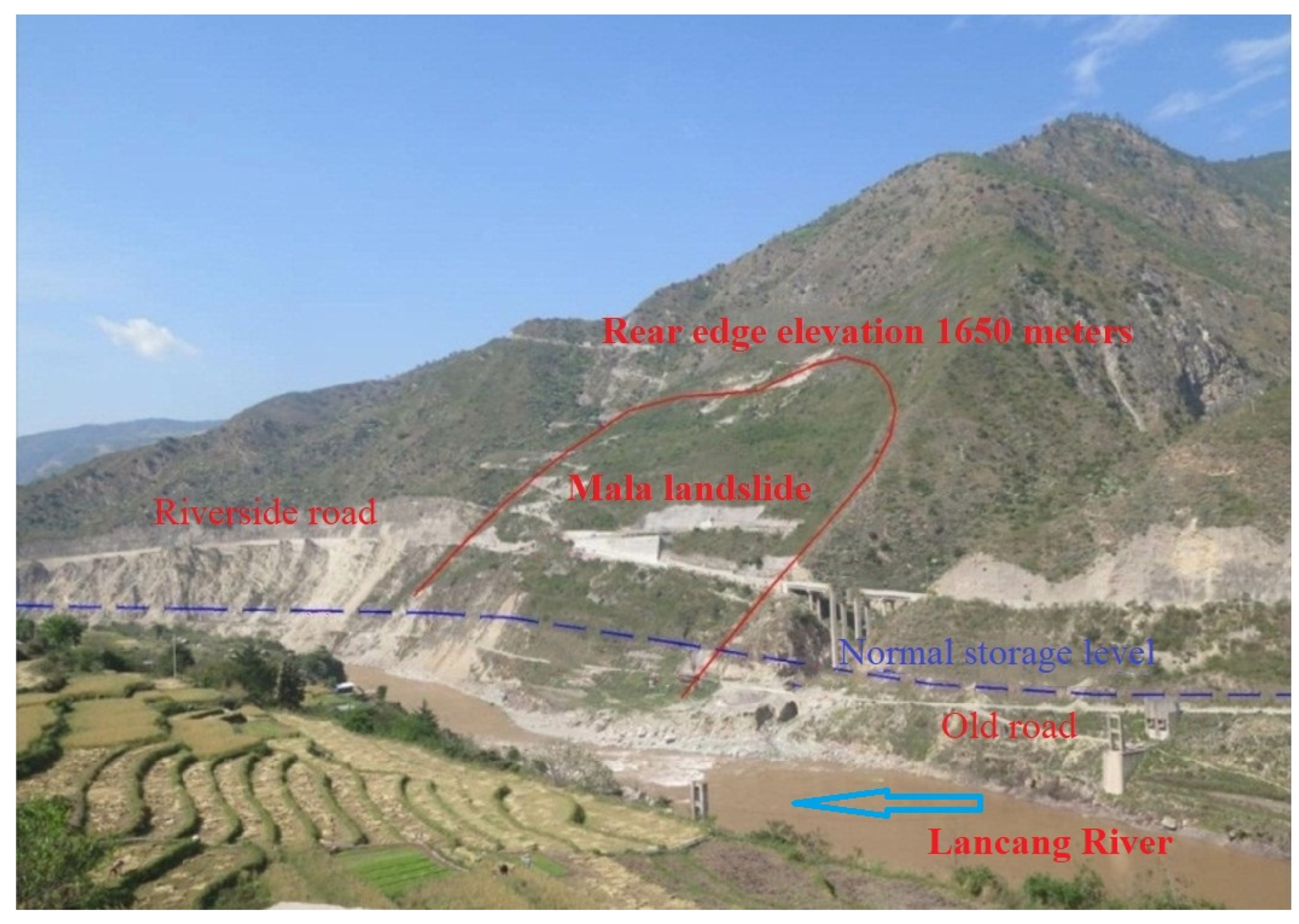


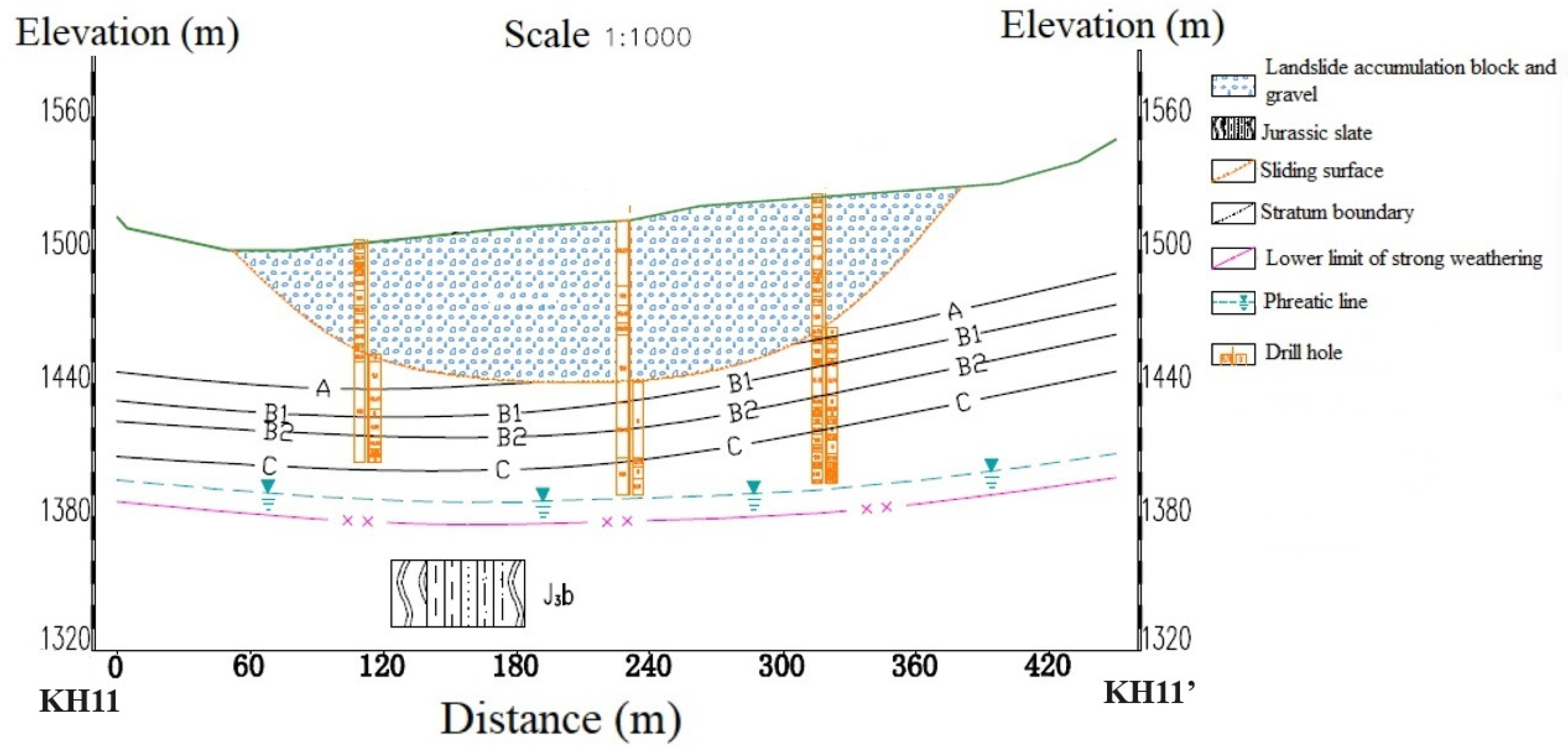
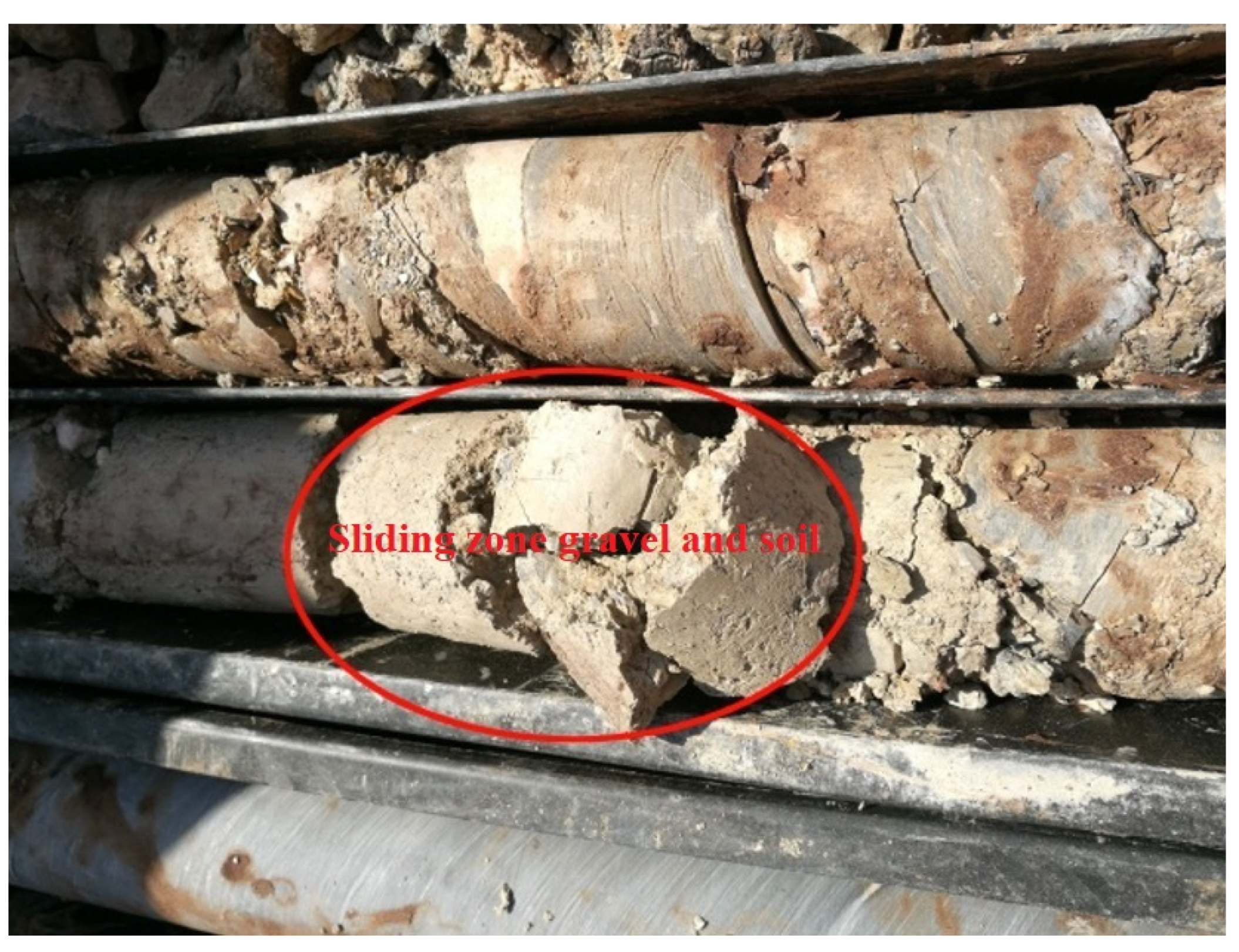


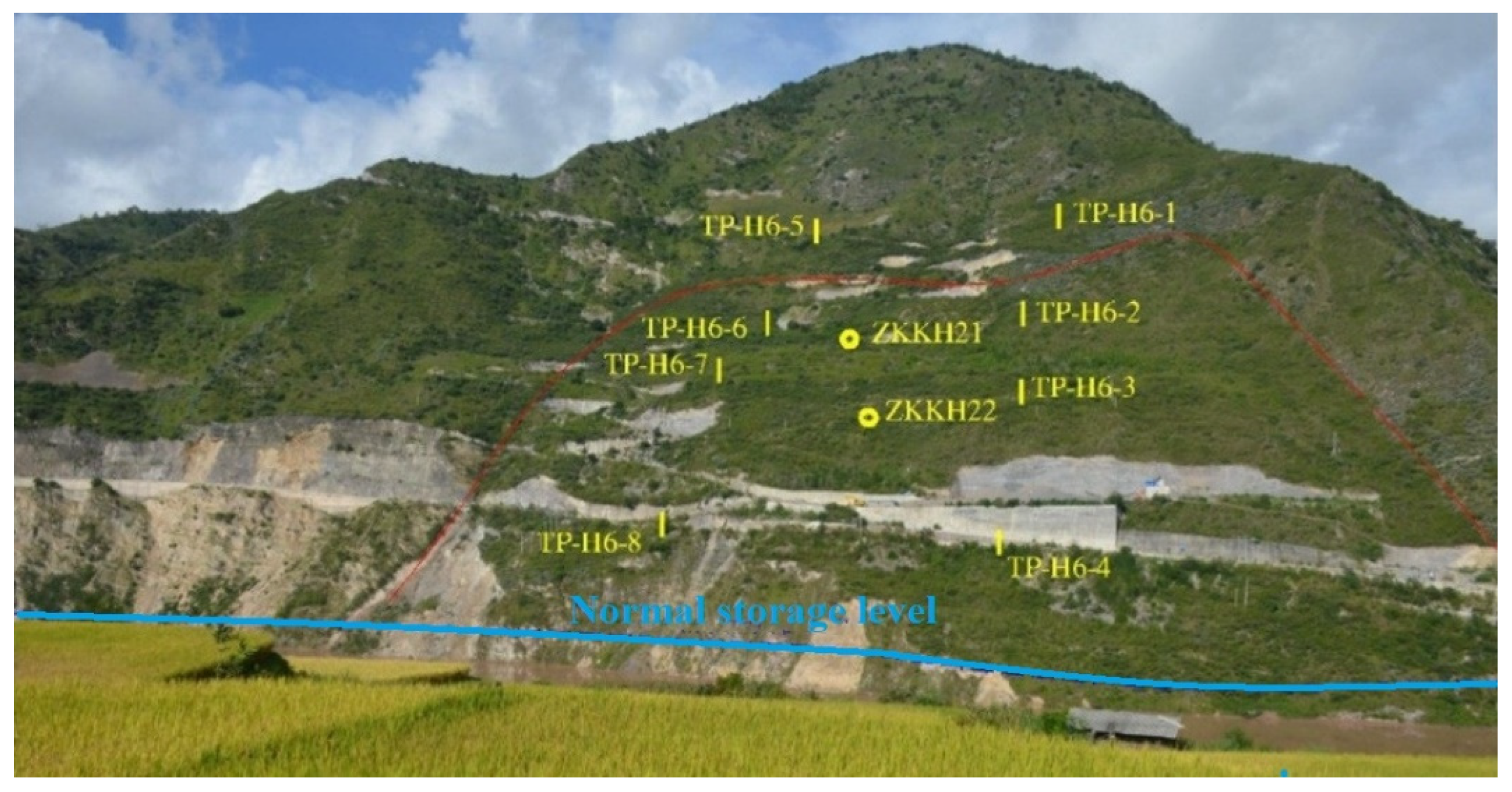
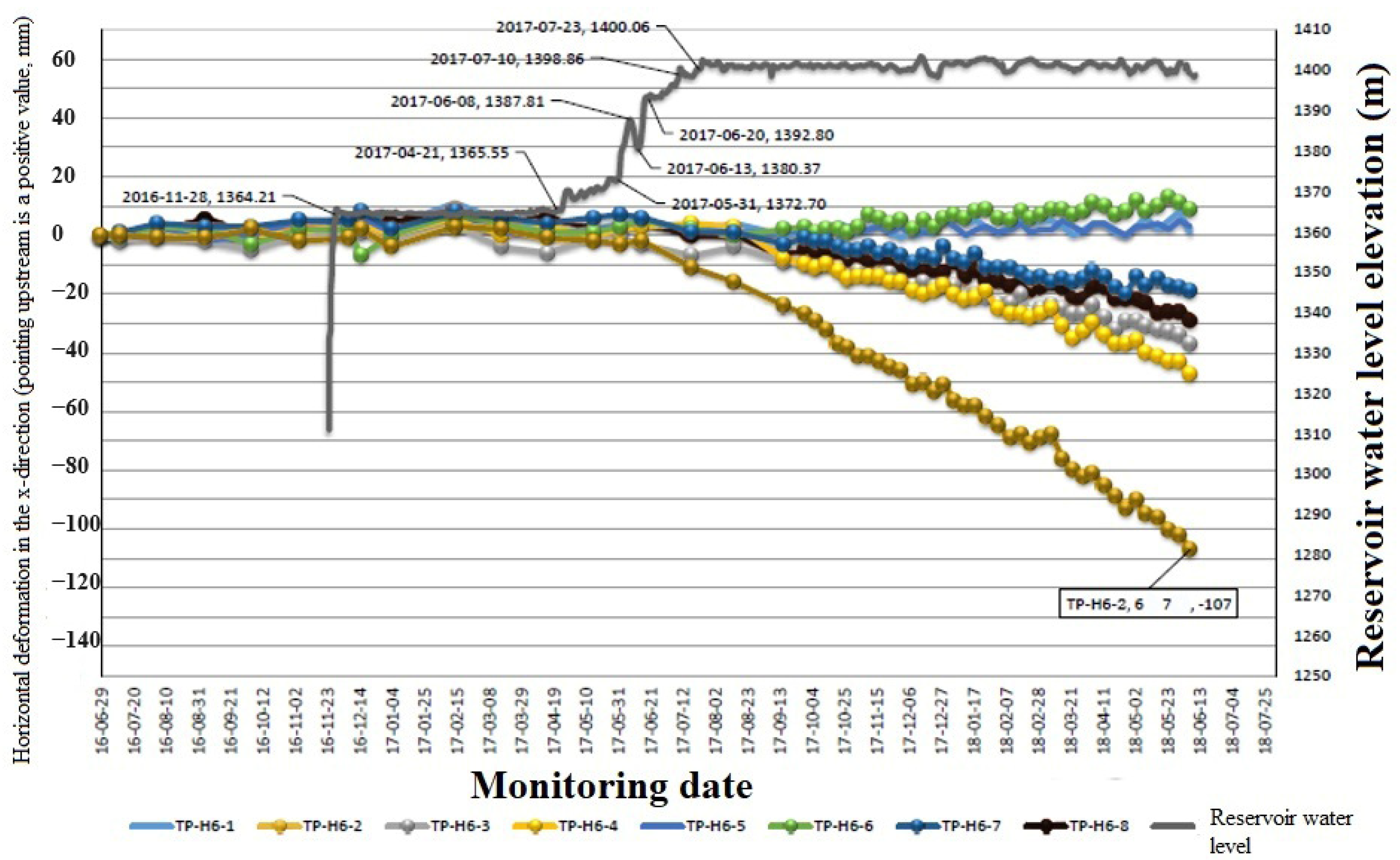
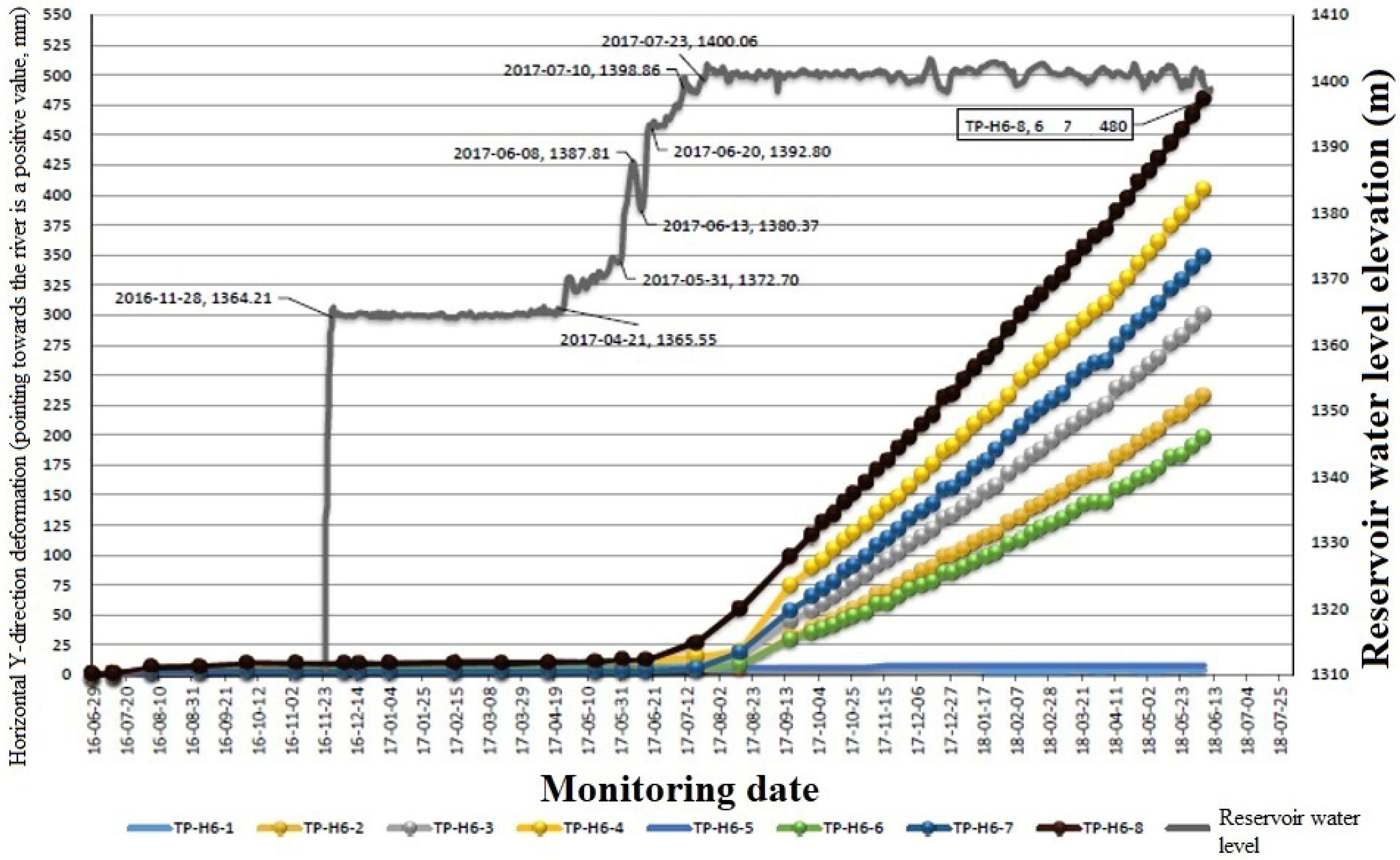
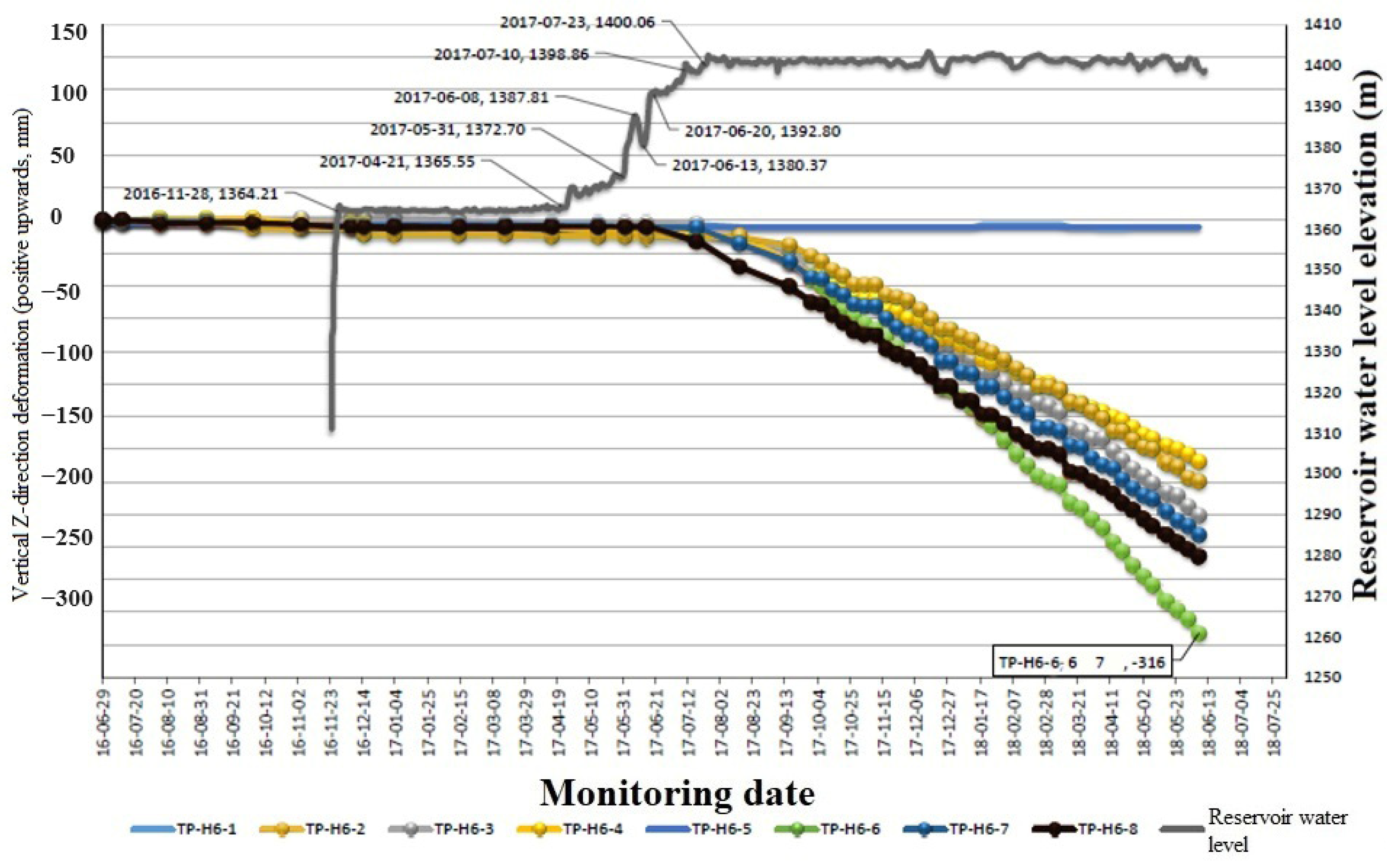
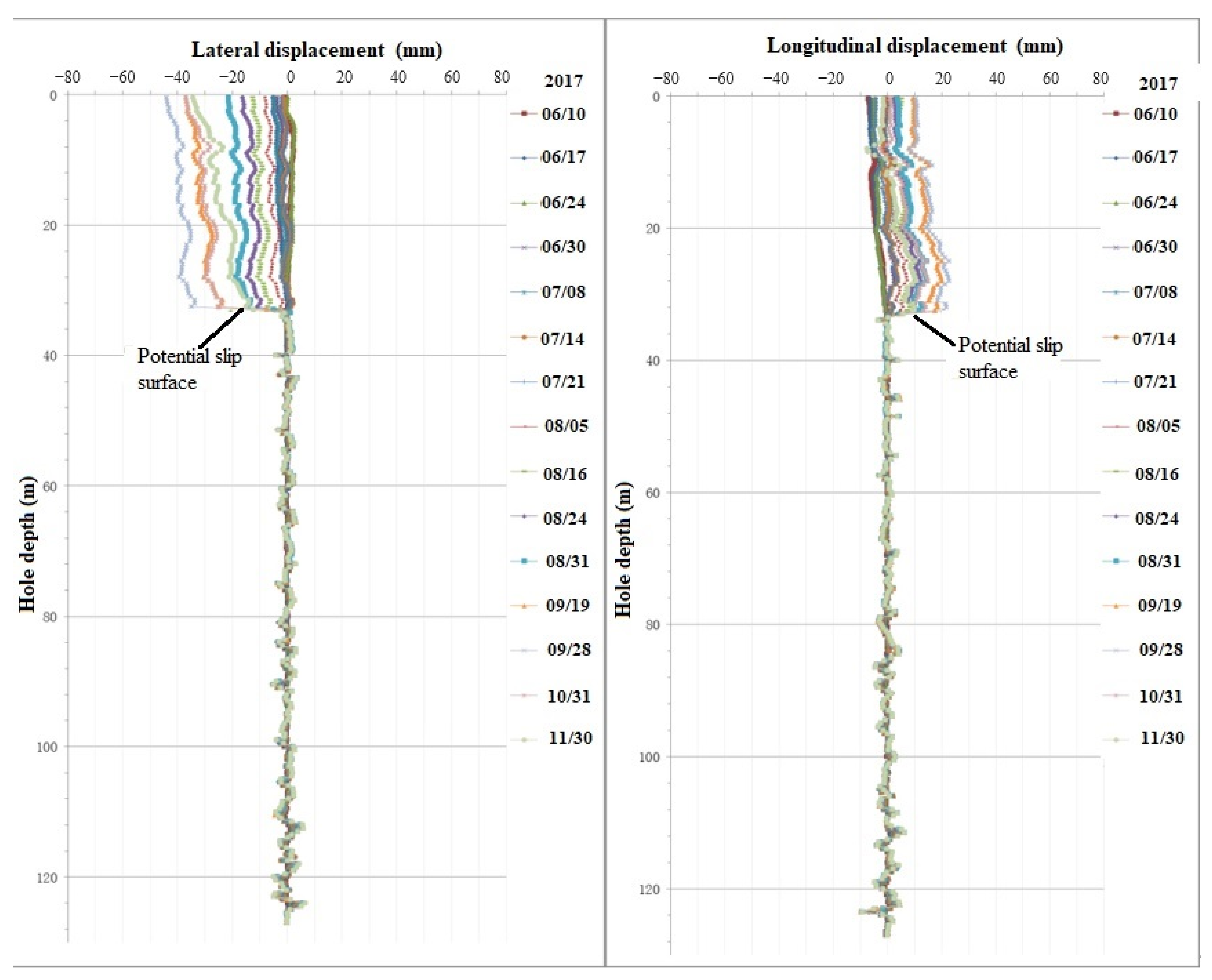

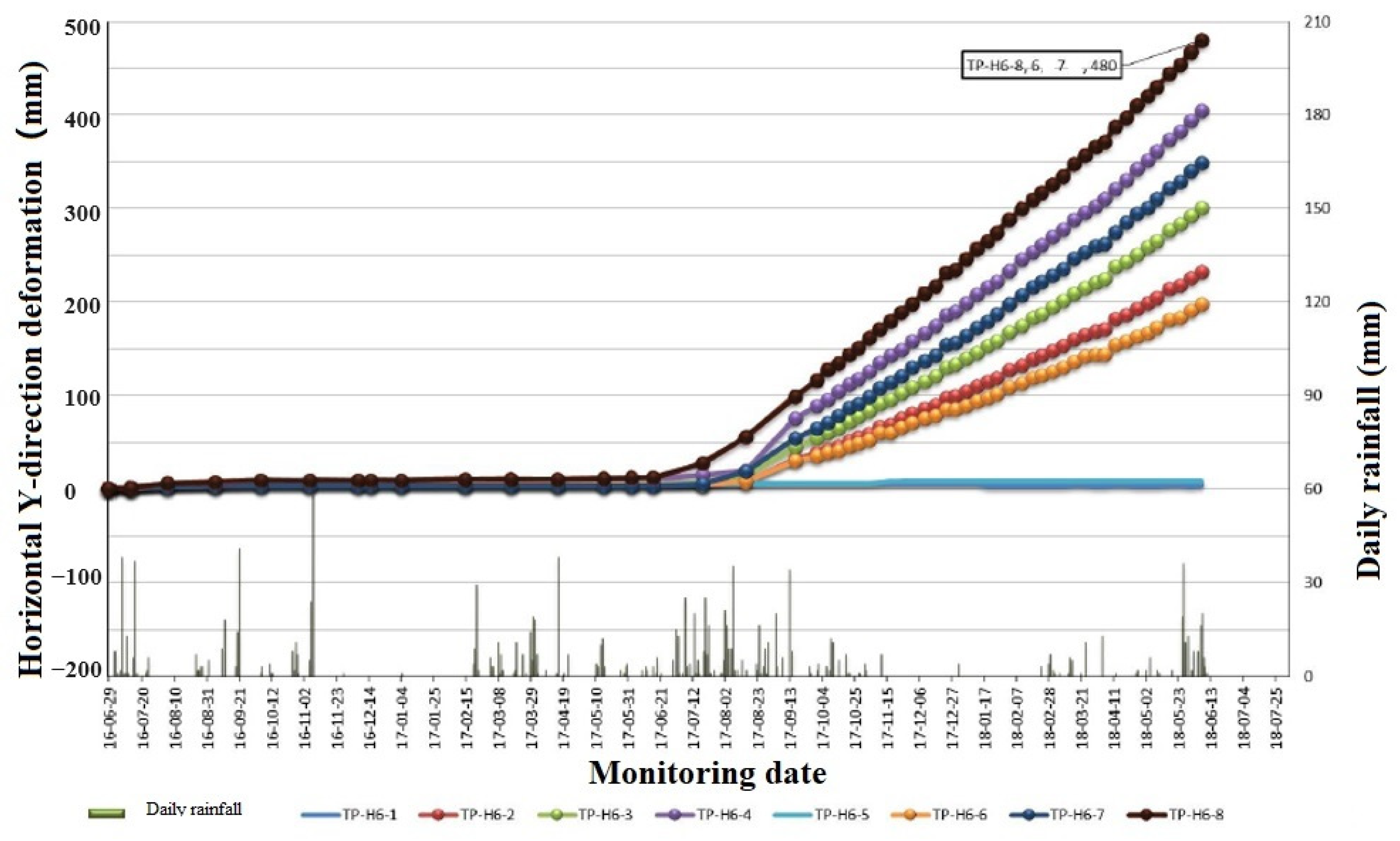
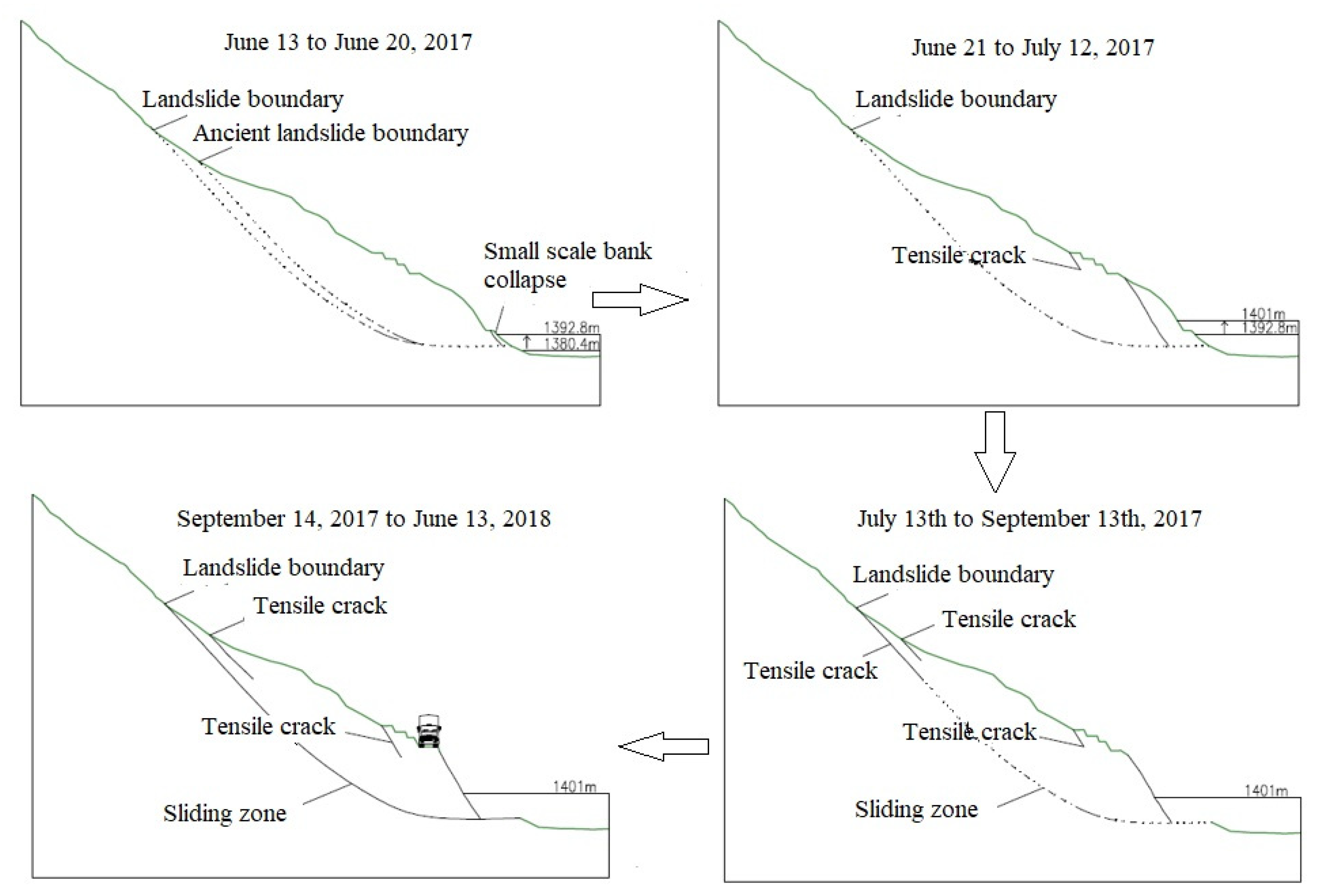
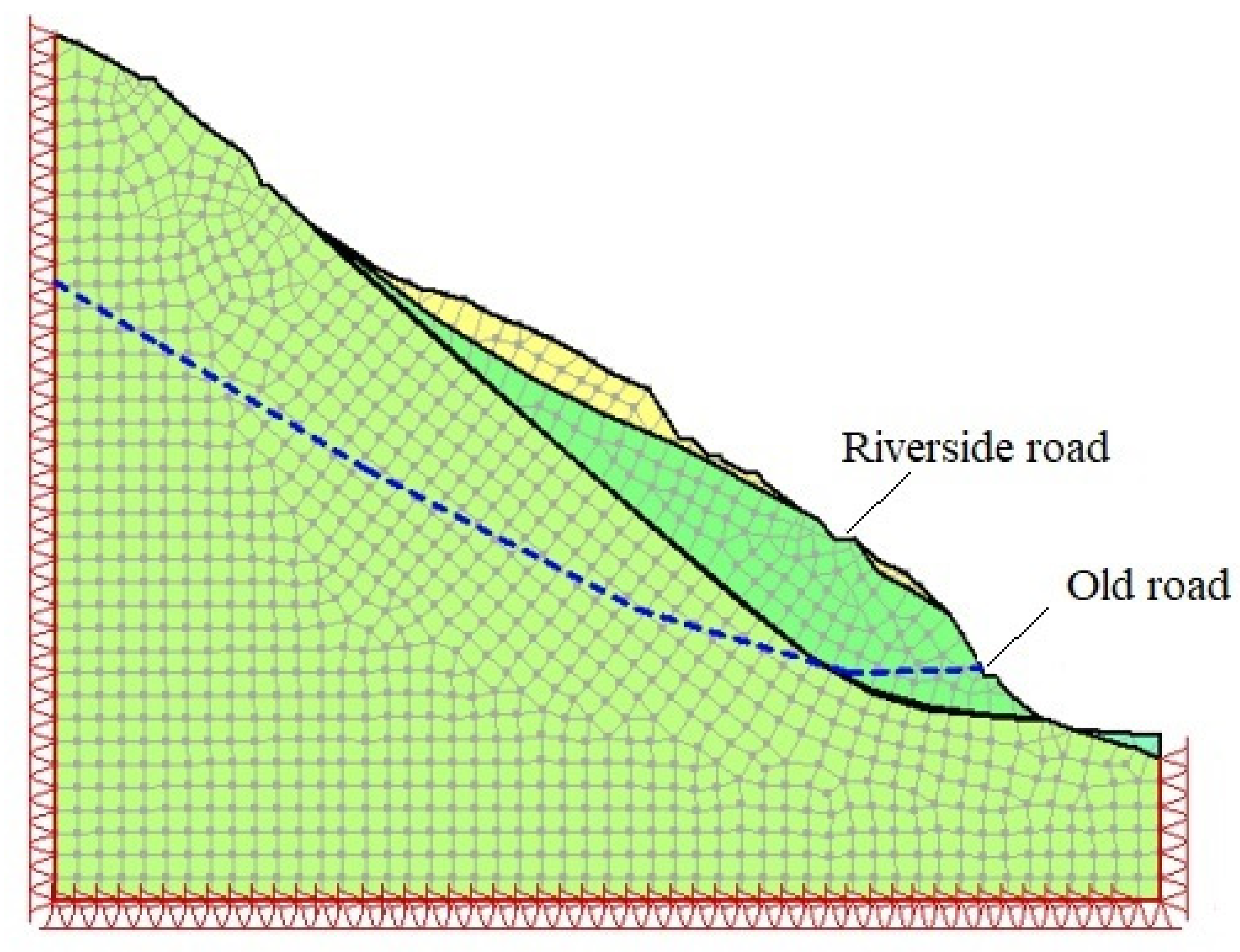
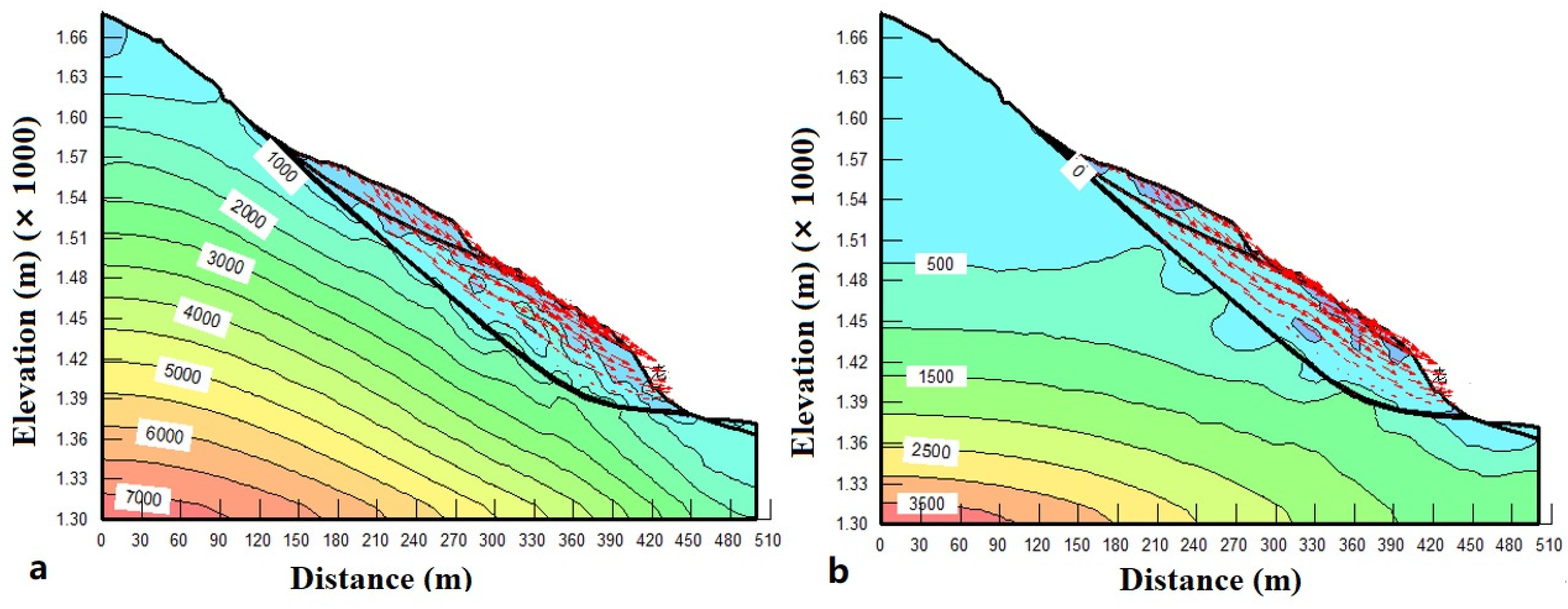

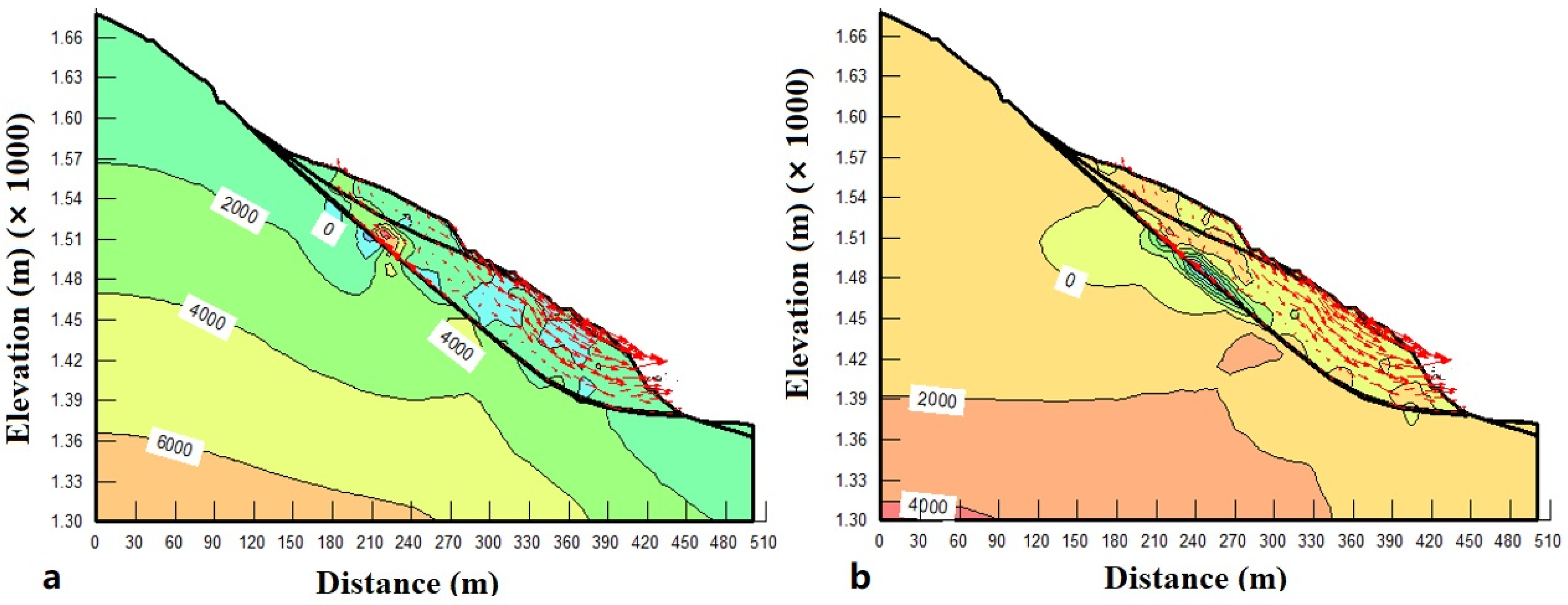
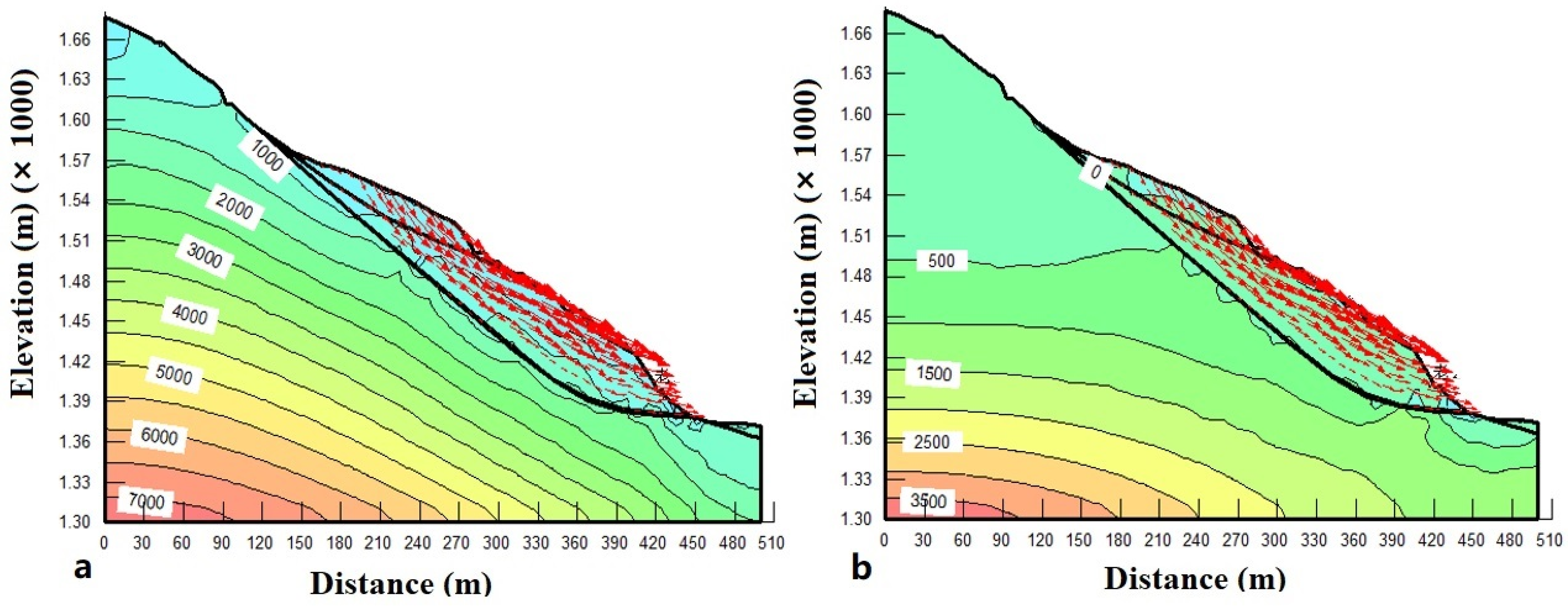
| Soil Sample Number | Dry Density (g/cm3) | Cohesion (kPa) | Internal Friction Angle (°) | |
|---|---|---|---|---|
| Triaxial consolidated undrained shear test | 1 | 1.7 | 10.66 | 28.0 |
| 2 | 1.7 | 9.58 | 27.6 | |
| 3 | 1.7 | 9.23 | 28.9 | |
| Saturated consolidation fast shear test | 1 | 1.6 | 2.2 | 27.5 |
| 2 | 1.6 | 4.1 | 27.3 | |
| 3 | 1.6 | 7.65 | 26.3 | |
| Repeated direct shear test | Soil sample number | Dry density (g/cm3) | Residual cohesion (kPa) | Residual internal friction angle (°) |
| 1 | 1.6 | 3.9 | 25.4 |
| Monitoring Point Number and Displacement Direction | TP-H6-1 | TP-H6-2 | TP-H6-3 | TP-H6-4 | TP-H6-5 | TP-H6-6 | TP-H6-7 | TP-H6-8 |
|---|---|---|---|---|---|---|---|---|
| Horizontal X Direction | 1 | −107 | −37 | −47 | 3 | 9 | −19 | −29 |
| Horizontal Y Direction | 4 | 232 | 301 | 405 | 8 | 198 | 349 | 480 |
| Vertical Z Direction | −5 | −200 | −226 | −185 | −5 | −316 | −241 | −258 |
| Monitoring Point Number and Displacement Direction | TP-H6-1 | TP-H6-2 | TP-H6-3 | TP-H6-4 | TP-H6-5 | TP-H6-6 | TP-H6-7 | TP-H6-8 |
|---|---|---|---|---|---|---|---|---|
| Horizontal X Direction | 0 | −0.31 | −0.11 | −0.15 | 0 | 0.03 | −0.07 | −0.10 |
| Horizontal Y Direction | 0 | 0.76 | 0.97 | 1.26 | 0 | 0.64 | 1.12 | 1.44 |
| Vertical Z Direction | 0 | −0.67 | −0.75 | −0.58 | 0 | −1.06 | −0.78 | −0.77 |
| Rock Mass Category | Unit Weight (kN/m3) | Deformation Modulus (MPa) | Cohesion (kPa) | Internal Friction Angle (°) | Poisson’s Ratio |
|---|---|---|---|---|---|
| Collapse slope deposit containing crushed stone and silty clay | 20 | 200 | 36.0 | 26.0 | 0.25 |
| Landslide accumulation block and gravel | 21.5 | 300 | 35.0 | 27.0 | 0.25 |
| Sliding zone | 17.0 | 100 | 8.0 | 25.0 | 0.23 |
| Bedrock | 24.0 | 1200 | 320.0 | 35.0 | 0.21 |
Disclaimer/Publisher’s Note: The statements, opinions and data contained in all publications are solely those of the individual author(s) and contributor(s) and not of MDPI and/or the editor(s). MDPI and/or the editor(s) disclaim responsibility for any injury to people or property resulting from any ideas, methods, instructions or products referred to in the content. |
© 2023 by the authors. Licensee MDPI, Basel, Switzerland. This article is an open access article distributed under the terms and conditions of the Creative Commons Attribution (CC BY) license (https://creativecommons.org/licenses/by/4.0/).
Share and Cite
Lv, J.; Shan, Z.; Yin, F.; Chen, L.; Dong, M.; Zhang, F. Deformation Characteristics and Stability Prediction of Mala Landslide at Miaowei Hydropower Station under Hydrodynamic Action. Water 2023, 15, 3942. https://doi.org/10.3390/w15223942
Lv J, Shan Z, Yin F, Chen L, Dong M, Zhang F. Deformation Characteristics and Stability Prediction of Mala Landslide at Miaowei Hydropower Station under Hydrodynamic Action. Water. 2023; 15(22):3942. https://doi.org/10.3390/w15223942
Chicago/Turabian StyleLv, Jingqing, Zhigang Shan, Fei Yin, Liang Chen, Menglong Dong, and Faming Zhang. 2023. "Deformation Characteristics and Stability Prediction of Mala Landslide at Miaowei Hydropower Station under Hydrodynamic Action" Water 15, no. 22: 3942. https://doi.org/10.3390/w15223942
APA StyleLv, J., Shan, Z., Yin, F., Chen, L., Dong, M., & Zhang, F. (2023). Deformation Characteristics and Stability Prediction of Mala Landslide at Miaowei Hydropower Station under Hydrodynamic Action. Water, 15(22), 3942. https://doi.org/10.3390/w15223942





